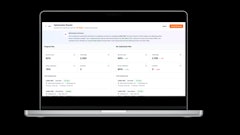
Around the globe, virtually every industry has been struggling with supply chain issues, with the freight industry getting much of the blame. Between protests that snarled traffic, blocked shipping routes and clogged ports, the last few years have shed light on just how fragile our transportation sector can be.
While certainly an inconvenience and an impact on the economy, it’s not a huge loss if clothing or patio furniture gets left sitting idle in a warehouse or parked in a trailer waiting for a driver or dock time. But when it comes to refrigerated foods, most notably protein and produce, the impact of supply chain disruption and volatility can be profound.
Just-in-time delivery is essential, and without it, there’s the potential for huge product losses when perishables miss their delivery window. And it doesn’t take long – mere hours sitting idle can have severe consequences. There are also significant sustainability concerns. Trucks must be left running even when parked to keep refrigeration units going, consuming large amounts of fuel and pumping out greenhouse gas emissions. Plus, there’s the moral conscience issue when food loss and waste occur while so much of the world is hungry.
With the refrigerated goods market expected to grow to $6.46 billion in the next year and increased demand for animal and plant-based alternative proteins, not to mention the seasonal variability in the produce market where every day counts, the freight industry must figure out how to iron out transportation issues.
The use of third-party freight optimization technology has become the most effective and flexible solution for maximizing efficiency, resource utilization and food safety. By leveraging algorithms to help mastermind the entire nationwide freight network, the fast-growing refrigerated trucking market can ensure more reliable delivery and more stable supplies of protein and produce on store shelves. Here’s how:
1) Dynamic capacity coordination. Lack of flexibility in warehouse pickup and delivery times often causes transportation bottlenecks, which means food is left sitting, compromising quality with every minute that goes by. With rigid schedules and no way to adjust dock times when hiccups occur, trucks, their drivers and their cargo are often left sitting and waiting when they could be on the road.
Third-party solutions can integrate capacity data from carriers and shippers’ schedules to coordinate dock times and available capacity to schedule pickup and delivery at the best times to optimize usage of available slots, equipment and driver time. And when issues arise – a truck is late due to traffic backup or mechanical issues, for example – the software can help shippers and carriers adapt, so nothing’s left sitting idle.
2) Better driver utilization. Across the entire freight system, the truck driver is the single regulated piece in the chain – their road time is limited, but they only get paid for drive time. Prioritizing the regulated piece above everything else would create more capacity and cut down on wasted time and empty miles to make sure freight is moving at every opportunity.
Using freight optimization tools that prioritize driver utilization can maximize drivers’ time on the road, reduce idle time for drivers and trucks and keep freight moving instead of sitting. That, in turn, can reduce unnecessary fuel consumption and greenhouse gas emissions to lower the environmental impact of refrigerated transport.
3) Improved shipper coordination. Too often, competitors in the food production market operate as though they’re competitors in logistics, too. Many refrigerated foods producers share the same storage warehouses and ship from the same docks but through totally independent and siloed operations. This is a missed opportunity to leverage coordinated resources to improve supply chain reliability. Instead of competing on freight procurement, they should compete on sales and brand position in the grocery case.
Working through a third-party freight optimization technology can allow shippers to collaborate and leverage synergies to maximize driver and resource utilization, which reduces redundancies, wasted time and resources. By coordinating freight needs, shippers can drive greater logistics efficiency for themselves and improve sustainability of the entire industry.
4) Chain of custody improvements. Food security is becoming a much greater concern, and as shippers become savvier in modern requirements, it’s creating higher standards for inventory tracking and visibility.
Using third-party optimization solutions can help leverage blockchain to always know the location, temperature and chain of custody for every piece of produce and every pack of meat in real time. This kind of detailed visibility can help the industry secure shipments and retrace every step to troubleshoot or coordinate a response faster.
Because the proximity of production to consumption will always be an issue and perishability a primary concern, refrigerated shipments require the maximum efficiency and agility to be able to adapt to changes in capacity demand on the fly. A produce shipper may not need any trucks to haul strawberries today, but tomorrow might need 20 trucks as peak season begins.
There’s not much we can do about shelf life or seasonal variability, but we can take steps to optimize the transportation of refrigerated goods to reduce hurdles that slow their progress from production to the shelf.
Using third-party freight optimization solutions allows shippers and carriers to tap into a larger network of capacity and loads to maximize resource utilization, reduce the risk of wasted time and product and leverage agility in the network to ensure more reliable distribution of produce and protein even when unexpected hurdles occur.



















